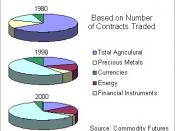When considering forward and futures contracts, it is important to distinguish between investment assets and consumption asset for the purpose of the investors. The consumption assets are assets held primarily for consumption purpose, therefore, the no-arbitrage theory cannot be used in pricing the futures and it is impossible to determine the futures price as a function of the spot price and other observable variables. This article uses futures in CBOT and NYMEX Futures Exchanges to illustrate the contract specifications, and how to hedge for each contract. It can be illustrated that hedging allows a market participant to lock in prices and the margins paid in advance can help to reduce the potential unanticipated loss. At last, this article discusses whet happen when early exercise an American put option.
1. Definition of assetAn investment asset is an asset held for investment purposes by significant numbers of investors. Stocks and bonds are clearly investment assets.
A consumption asset is an asset held primarily for consumption purpose. It is usually not held for investment. Examples of consumption assets are copper, oil, and pork bellies.
2.Pricing theoryAs stated above, there is a significant difference between the investment asset and the consumption asset. Therefore, the method of pricing the futures contracts is different.
First, the investment decision has no influence from consumption and the other purposes, the investor just pursue the risk yield in the financial asset not the asset itself, the underlying asset and the futures can be substituted each other. Knowing that the price is not reasonable, the investor makes a choice between the two assets. Thus, the pricing of an investment asset is a pure problem of finance, and the no-arbitrage theory becomes the principle theory of future pricing. Therefore, it is possible to obtain the futures price as a function...


